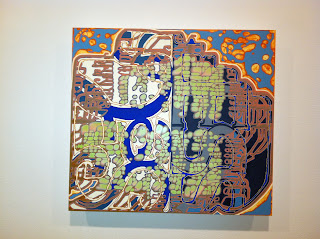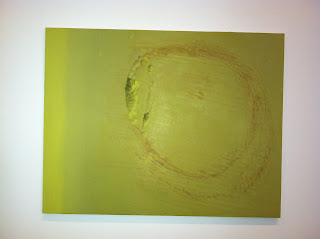Michelangelo knew that the meaning of the Greek humanities for his time
involved making Christ-the man, into Christ-who is God; that his plastic
problem was neither the mediaeval one, to make a cathedral, nor the Greek one, to make a man
like a god, but to make a cathedral out of man. In doing so he
set a standard for sublimity that
the painting of his time could not
reach. Instead, painting continued on its merry quest for a voluptuous art until in modern
times, the Impressionists, disgusted with its inadequacy, began the movement to destroy the
established rhetoric of beauty by
the Impressionist insistence on a
surface of ugly strokes.
The impulse of modern art was this desire to destroy beauty. However, in discarding Renaissance notions of beauty, and without an adequate substitute for a sublime message, the Impressionists were compelled to preoccupy themselves, in their struggle, with the cultural values of their plastic history so that instead of evoking a new way of experiencing life they were able only to
make a transfer of values. By glorifying their own way of living, they were
caught in the problem of what is really beautiful and could only make a restatement of their position on the general question of beauty; just as later
the Cubists, by their Dada gestures of substituting a sheet of newspaper
and sandpaper for both the velvet surfaces of the Renaissance and the
Impressionists, made a similar transfer of values instead of creating a new
vision, and succeeded only in elevating the sheet of paper. So strong is
the grip of the rhetoric of exaltation as an attitude in the large context of
the European culture pattern that the elements of sublimity in the revolution we know as modern art, exist in its effort and energy to escape the
pattern rather than in the realization of a new experience. Picasso's effort
may be sublime but there is no doubt that his work is a preoccupation with
the question of what is the nature of beauty. Even Mondrian, in his attempt
to destroy the Renaissance picture by his insistence on pure subject matter, succeeded only in raising the white plane and the right angle into a
realm of sublimity, where the sublime paradoxically becomes an absolute
of perfect sensations. The geometry (perfection) swallowed up his metaphysics (his exaltation).
The failure of European art to achieve the sublime is due to this blind desire to exist inside the reality of sensation (the object world, whether distorted or pure) and to build an art within the framework of pure plasticity
(the Greek ideal of beauty, whether that plasticity be a romantic active surface, or a classic stable one). In other words, modern art, caught without a
sublime content, was incapable of creating a new sublime image, and unable to move away from the Renaissance imagery of figures and objects
except by distortion or by denying it completely for an empty world of
geometric formalisms—a pure rhetoric of abstract mathematical relationships, became enmeshed in a struggle over the nature of beauty; whether
beauty was in nature or could be found without nature.
I believe that here in America, some of us, free from the weight of European culture, are finding the answer, by completely denying that art has
any concern with the problem of beauty and where to find it. The question
that now arises is how, if we are living in a time without a legend or mythos
that can be called sublime, if we refuse to admit any exaltation in pure relations, if we refuse to live in the abstract, how can we be creating a sublime art?
We are reasserting man's natural desire for the exalted, for a concern with
our relationship to the absolute emotions. We do not need the obsolete
props of an outmoded and antiquated legend. We are creating images
whose reality is self-evident and which are devoid of the props and
crutches that evoke associations with outmoded images, both sublime and
beautiful. We are freeing ourselves of the impediments of memory, association, nostalgia, legend, myth, or what have you, that have been the devices of Western European painting. Instead of making cathedrals out of
Christ, man, or "life," we are making it out of ourselves, out of our own
feelings. The image we produce is the self-evident one of revelation, real
and concrete, that can be understood by anyone who will look at it without
the nostalgic glasses of history.
* Excerpt from "The Ides of Art, Six Opinions on What is Sublime in Art?", Tiger's Eye
(New York), No.6 (15 December 1948), pp. 52-53.










































































